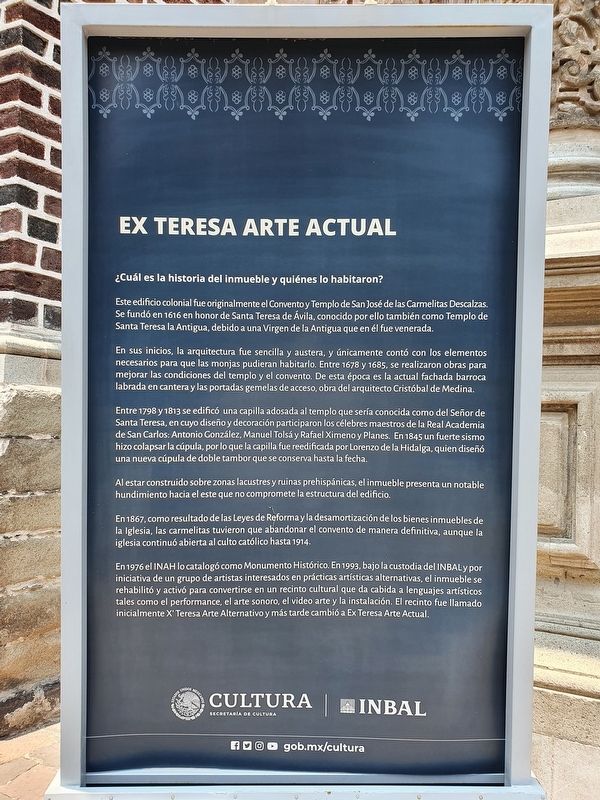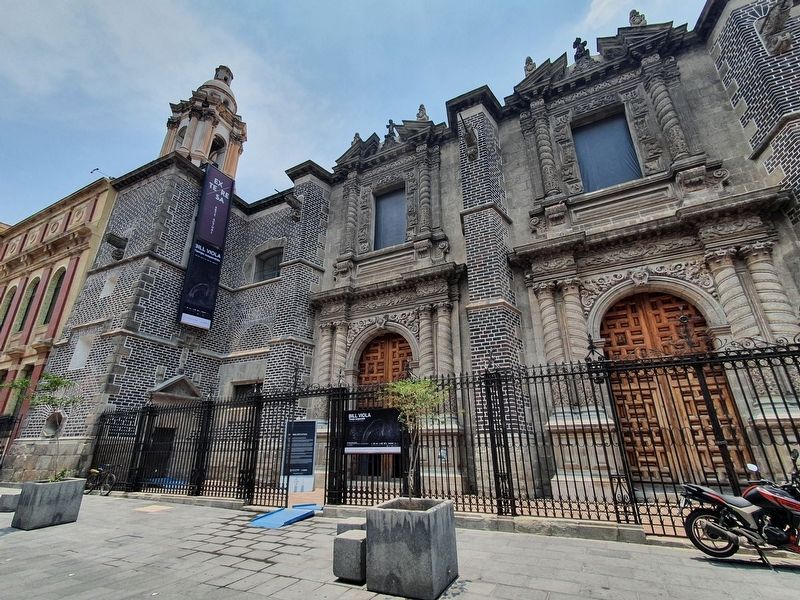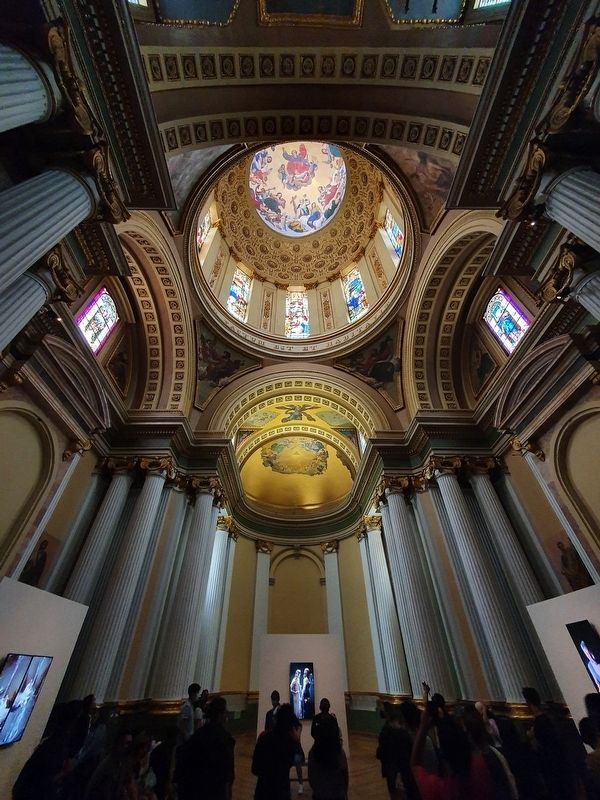Centro Histórico in Ciudad de México, Mexico — The Valley of Mexico (The Central Highlands)
Ex Teresa Arte Actual
¿Cuál es la historia del inmueble y quienes lo habitaron?
Este edificio colonial fue originalmente el Convento y Templo de San José de las Carmelitas Descalzas. Su fundó en 1616 en honor de Santa Teresa de Ávila, conocido por ello también como Templo de Santa Teresa la Antigua, debido a una Virgen de la Antigua que en él fue venerada.
En sus inicios, la arquitectura fue sencilla y austera, y únicamente contó con los elementos necesarios para que las monjas pudieron habitarlo. Entre 1678 y 1685, se realizaron obras para mejorar las condiciones del templo y el convento. De esta época es la actual fachada barroca labrada en cantera y las portadas gemelas de acceso, obra del arquitecto Cristóbal de Medina.
Entre 1798 y 1813 se edificó una capilla adosada al templo que sería conocida como del Señor de Santa Teresa en cuyo diseño y decoración participaron los célebres maestros de la Real Academia de San Carlos: Antonio González, Manuel Tolsá y Rafael Ximeno y Planes. En 1845 un fuerte sismo hizo colapsar la cúpula, por lo que la capilla fue reedificada por Lorenzo de la Hidalga, quien diseño una nueva cúpula de doble tambor que se conserva hasta la fecha.
Al estar construido sobre zonas lacustres y ruinas prehispánicas, el inmueble presenta un notable hundimiento hacia el este que no compromete la estructura del edificio.
En 1867, como resultado de las Leyes de Reforma y la desamortización de los bienes inmuebles de la Iglesia, las carmelitas tuvieron que abandonar el convento de manera definitiva, aunque la iglesia continuó abierta al culto católico hasta 1914.
En 1976 el INAH lo catalogó como Monumento Histórico. En 1993, bajo la custodia del INBAL y por iniciativa de un grupo de artistas interesados en práticas artísticas alternativas, el inmueble se rehabilitó y activó para convertirse en un recinto cultural que da cabida a lenguajes artísticos tales como el performance, el arte sonoro, el video arte y la instalación. El recinto fue llamado inicialmente X’ Teresea Arte Alternativo y más tarde cambió a Ex Teresa Arte Actual.
>Ex Teresa Arte Actual
What is the history of the property and who inhabited it?
This colonial building was originally the Convent and Temple of San José de las Carmelitas Descalzas. It was founded in 1616 in honor of Santa Teresa de Ávila, also known as the Temple of Santa Teresa la Antigua, due to a Virgin of Antigua who was venerated here.
In its beginnings, the architecture was simple and austere, and only had the necessary elements so that the nuns could inhabit it. Between 1678 and 1685, works were carried out to improve the conditions of the temple and the convent. From this period is the current baroque façade carved in quarried stone and the twin entrances, the work of the architect Cristóbal de Medina.
Between 1798 and 1813 a chapel was built attached to the temple that would be known as the Lord of Santa Teresa in whose design and decoration the famous masters of the Royal Academy of San Carlos participated: Antonio González, Manuel Tolsá y Rafael Ximeno y Planes. In 1845 a strong earthquake caused the dome to collapse, so the chapel was rebuilt by Lorenzo de la Hidalga, who designed a new double drum dome that is preserved to this day.
Being built on lake areas and pre-Hispanic ruins, the property has a notable sinking to the east that does not compromise the structure of the building.
In 1867, as a result of the Reform Laws and the confiscation of the Church's real estate, the Carmelites had to leave the convent permanently, although the church remained open to Catholic worship until 1914.
In 1976 the INAH listed it as a Historical Monument. In 1993, under the custody of INBAL and on the initiative of a group of artists interested in alternative artistic practices, the building was rehabilitated and activated to become a cultural venue that accommodates artistic languages such as performance, sound art, and installation. The venue was initially called X' Teresea Arte Alternativo and later changed to Ex Teresa Arte Actual.
Topics. This historical marker is listed in these topic lists: Arts, Letters, Music • Churches & Religion • Colonial Era. A significant historical year for this entry is 1616.
Location. 19° 26.052′ N, 99° 7.847′ W. Marker is in Ciudad de México. It is in Centro Histórico. Marker is on Licenciado Verdad just north of Moneda, on the right when traveling north. Touch for map. Marker is at or near this postal address: Lic Verdad 8, Ciudad de México 06000, Mexico. Touch for directions.
Other nearby markers. At least 8 other markers are within walking distance of this marker. Palacio de la Autonomía (here, next to this marker); Baroque Entryway (a few steps from this marker); History of the Convent (within shouting distance of this marker); Colonial Arch and Platform from Phase V (within shouting distance of this marker); South Red Temple (within shouting distance of this marker); Manuel Nicolás Carpancho (within shouting distance of this marker); Templo Mayor Museum (within shouting distance of this marker); Eastern Border of the Sacred Center (within shouting distance of this marker). Touch for a list and map of all markers in Ciudad de México.
Credits. This page was last revised on February 7, 2023. It was originally submitted on September 28, 2022, by J. Makali Bruton of Accra, Ghana. This page has been viewed 105 times since then and 14 times this year. Photos: 1, 2, 3. submitted on September 28, 2022, by J. Makali Bruton of Accra, Ghana.


